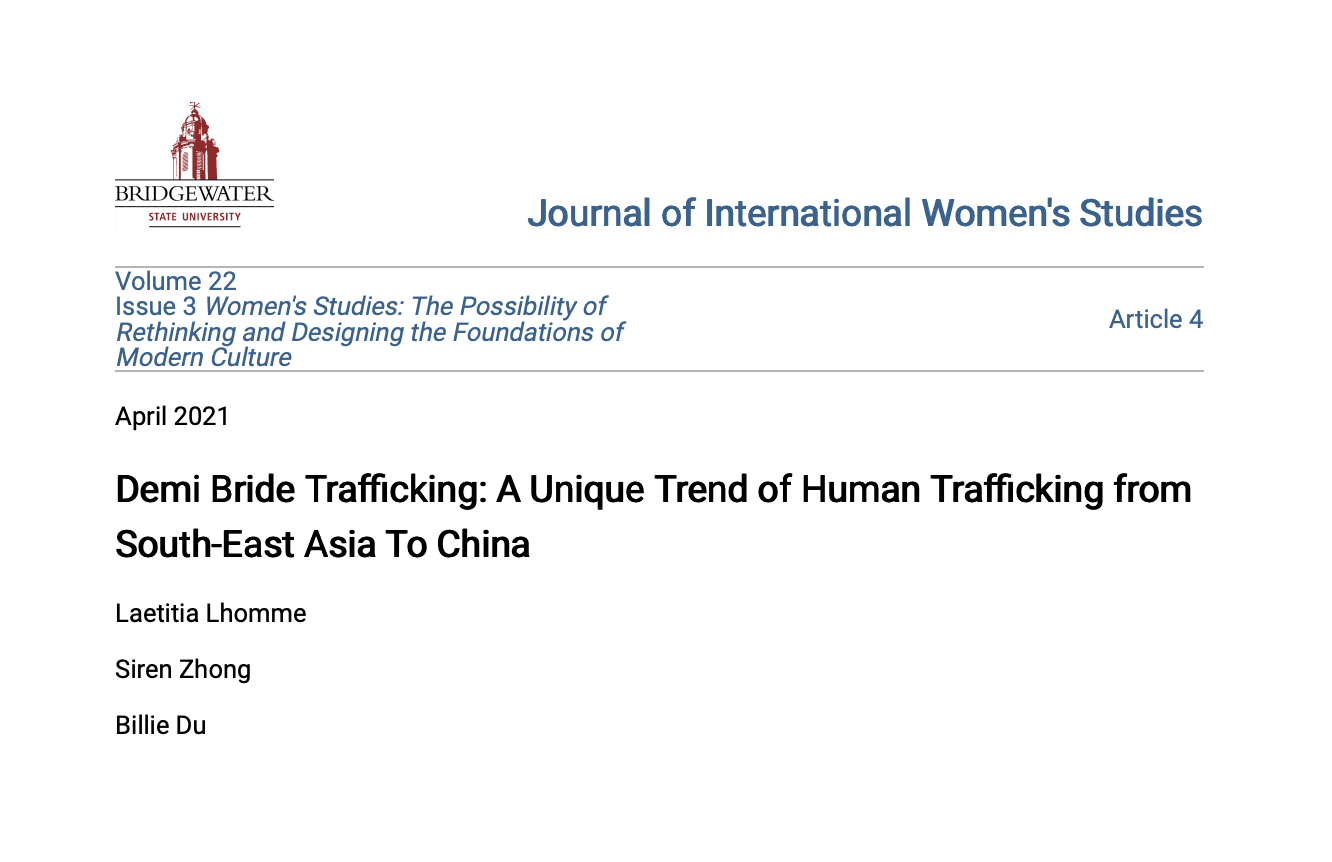
Demi Bride Trafficking: A Unique Trend of Human Trafficking from South-East Asia To China
Abstract
Every year, hundreds of thousands of women and girls from Southeast Asia are forced or tricked into marrying Chinese men who exploit them for sex and childbearing. Although an emerging body of research and reports has revealed the scale and living conditions of the trafficked brides, there have not yet been systematic studies that would help stakeholders understand the real needs of the victims. Bride trafficking victims are generally defined as those who are deprived of their rights and married against their will. However, our investigation found that in China, cases which involve seemingly willing victims are barely covered by the current trafficking victim identification system, despite the existence of “the principle of the irrelevance of consent” (UNODC, 2014). Due to the lack of unified measures and feasible research methods, empirical research on such groups is very limited. In an effort to fill this gap, this article identifies this category as “demi bride trafficking” and includes an academic exploration of the transnational trafficked marriages in China as well as a descriptive analysis based on the interviews of various NGOs, experts, and government officials. By analysing the dysfunction of external interventions and the potential link between the Belt Road Initiative and the increasing number of human trafficking cases, this paper then suggests that currently, the most effective solution is to address it internally, with a focus on fulfilling victims’ individual demands, which in turn requires an individual tailored victim protection system to be built.
Introduction
Bride trafficking from Southeast Asia to China can be dated back to the 1980s. During that period, borders in Southeast Asia began to open, and transnational financial activities were growing. The weak management control system in the border areas promoted the human trafficking industry. That is, with the natural geographical advantage of the Great Mekong Subregion (GMS), new networks and cross-border transportations made it more convenient for traffickers to transport victims from China, Myanmar, Laos, and Thailand to supply sex trade (Emmers, 2003).
Since 2000, however, following China’s economic growth, the number of bride trafficking cases from the GMS to China has gradually increased and become one of the primary forms of cross-border human trafficking in the region. According to the Vietnamese official data, more than 3,000 women and children were trafficked between 2012 and 2017 (Vu, 2018). In the same period, Kachin Women’s Association Thailand (KWAT) has estimated that 7,500 Myanmar women had gone through forced marriage and childbearing to Chinese men, and those women suffered from both psychological and physical abuse (Robinson & Branchini, 2018). All these figures reveal just the tip of the iceberg of the bride trafficking industry from Southeast Asian countries to China.
Corresponding to this increase in transnational bride trafficking, the Chinese government modified its national laws to respond to the international standard of countering human trafficking. However, its practices are still limited because neither the Palermo Protocol nor China’s domestic laws explicitly include bride trafficking in its definition of human trafficking. As a whole, China still has no effective laws for preventing bride trafficking. But even if specific law modifications that counter bride trafficking were passed in the next few years, this problem would not be wholly solved. The transnational bride trafficking phenomenon is still far from being eradicated through legal regulations, mainly due to the complexities lying behind the trafficking itself.
The crux of this paper’s purpose is to answer the questions: what are the unique characteristics of bride trafficking in China and what are the main needs of the victims? The methodological framework of this paper combines half-structural interviews with NGOs and Chinese government officials who implemented the victim assistance/resettlement project, as well as analysis of secondary resources. This analysis will start with a brief explanation of the bride purchasing phenomenon in China. It will then introduce the unique form of human trafficking in China, which we defined as “demi-bride trafficking”. This unusual type of trafficking is neglected a lot by previous researchers, and the related victims are not covered by the current victim identification system. By exploring the existing counter-human trafficking operations in China and how the whole industry is expanding alongside China’s developing plans, this paper emphasises the urgency and potential approaches to build an individual tailored victim protection system.
Read more here.
